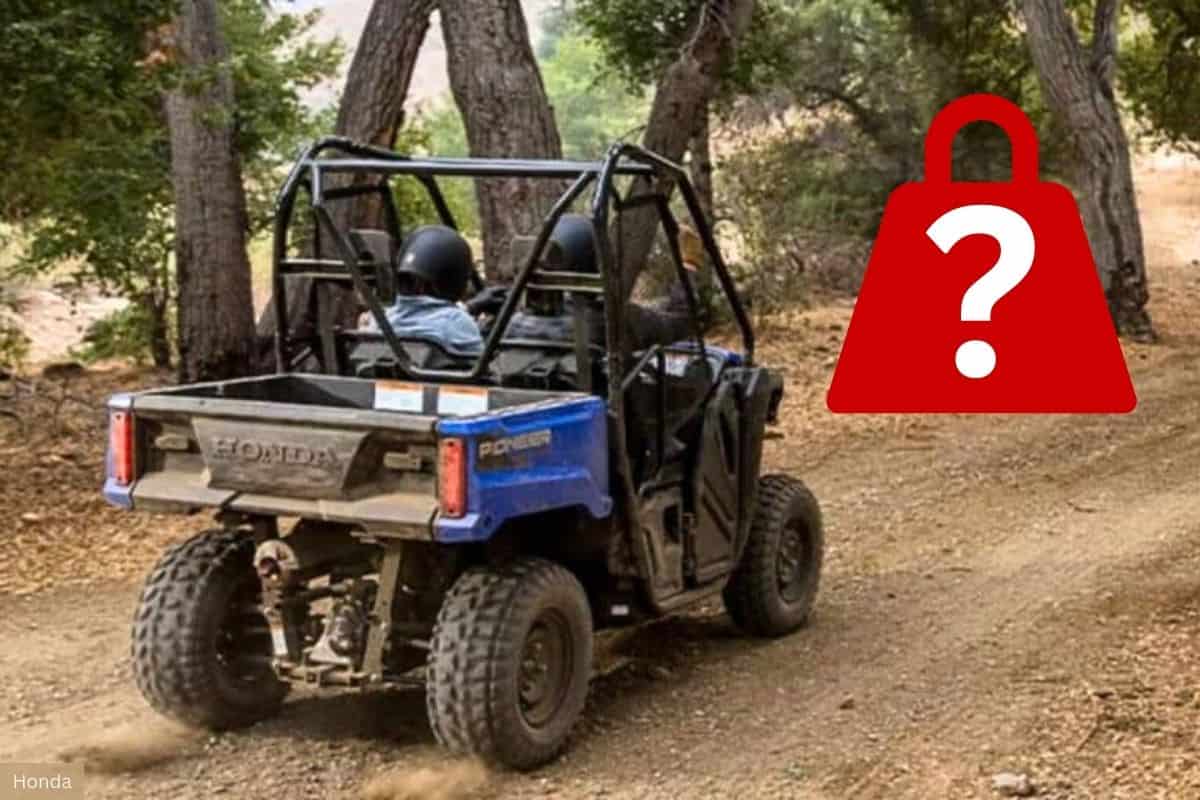Side by sides, also known as UTVs, are used by a wide range of outdoor enthusiasts from off-roaders to farmers to ranchers, and hunters.
As these versatile machines offer a unique blend of performance, utility, and capability, making them suitable for a variety of applications.
An important factor to consider when choosing one though is side-by-side weight, as this can significantly impact the UTV’s performance, maneuverability, and overall functionality.
In this blog post, we’ll dive deep into side-by-side weight, comparing 25 popular models across various categories, to discover the average weight of a UTV or side-by-side.
Key Takeaways
- The average weight of a side-by-side or UTV is approximately 1,603 pounds (727 kg), with most models falling between 1,000 and 2,000 pounds (450-900 kg).
- Factors such as engine size and type, construction materials, vehicle size, and dimensions can significantly impact a side-by-side’s overall weight.
- Side-by-side weight can greatly influence its performance characteristics, including maneuverability, handling, acceleration, top speed, and towing capacity.
Side By Side Weight (Lightest to Heaviest)
| Make/Model/Trim | Weight | Class | Seating Capacity |
|---|---|---|---|
| 1. Kawasaki Mule SX | 967 lbs | Utility | 2-Up |
| 2. Honda Pioneer 500 | 1,027 lbs | Sport/Trail | 2-Up |
| 3. Massimo Motor Buck 450 | 1,113 lbs | Utility | 2-Up |
| 4. Polaris Ranger SP 570 | 1,158 lbs | Utility | 2-Up |
| 5. Can-Am Maverick Trail 700 | 1,256 lbs | Sport/Trail | 2-Up |
| 6. John Deere XUV560E | 1,259 lbs | Utility | 2-Up |
| 7. CFMoto UForce 600 | 1,356 lbs | Utility | 2-Up |
| 8. Can-Am Maverick Trail DPS 1000 | 1,364 lbs | Sport/Trail | 2-Up |
| 9. CFMoto ZForce 800 Trail EPS | 1,390 lbs | Sport/Trail | 2-Up |
| 10. Yamaha YXZ 1000R | 1,574 lbs | Sport/Trail | 2-Up |
| 11. Honda Pioneer 1000 | 1,598 lbs | Utility | 2-Up |
| 12. Arctic Cat Prowler Pro EPS | 1,605 lbs | Utility | 2-Up |
| 13. Segway Fugleman UT10 | 1,653 lbs | Utility | 2-Up |
| 14. Can-Am Commander XT 1000 | 1,675 lbs | Sport/Trail | 2-Up |
| 15. Kubota Sidekick RTV-XG850 | 1,761 lbs | Utility | 2-Up |
| 16. Yamaha Viking VI EPS | 1,761 lbs | Utility | 4-Up |
| 17. Honda Talon 1000X-4 Fox Live Valve | 1,790 lbs | Sport/Trail | 4-Up |
| 18. Can-Am Defender Cab DPS HD9 | 1,830 lbs | Utility | 2-Up |
| 19. Kawasaki Teryx KRX 1000 | 1,896 lbs | Sport/Trail | 2-Up |
| 20. John Deere XUV835E | 1,898 lbs | Utility | 2-Up |
| 21. Arctic Cat Wildcat XX Black Hills Edition | 1,918 lbs | Sport/Trail | 2-Up |
| 22. Kawasaki Mule PRO-FXT | 1,922 lbs | Utility | 4-Up |
| 23. Segway Villain SX10 WX | 1,940 lbs | Sport/Trail | 2-Up |
| 24. Polaris Ranger Crew XP 1000 | 1,953 lbs | Utility | 4-Up |
| 25. Polaris RZR Turbo R Ultimate | 2,013 lbs | Sport/Trail | 2-Up |
Average Side by Side Weight
The average weight of a side-by-side can vary significantly depending on the model, manufacturer, or brand, and intended use.
However, most UTVs weigh between 1,000 and 2,000 pounds (450 kg – 900 kg), with the average weight being approximately 1,603 pounds (727 kg).
This average was estimated from a wide range of models, including both 2-up and 4-up seating configurations, as well as utility and sport/trail-oriented side-by-sides.
It’s worth noting that the average weight of utility-focused UTVs tends to be slightly higher than that of sport/trail models.
As utility UTVs often feature larger cargo beds, more robust construction, and additional features like cab enclosures or dump beds, which contribute to their increased weight.
Sport/trail models, on the other hand, prioritize agility, speed, and off-road performance, often featuring lighter-weight materials and more compact designs.
Lightweight Side-By-Sides: (1,000 – 1,300 Pounds)
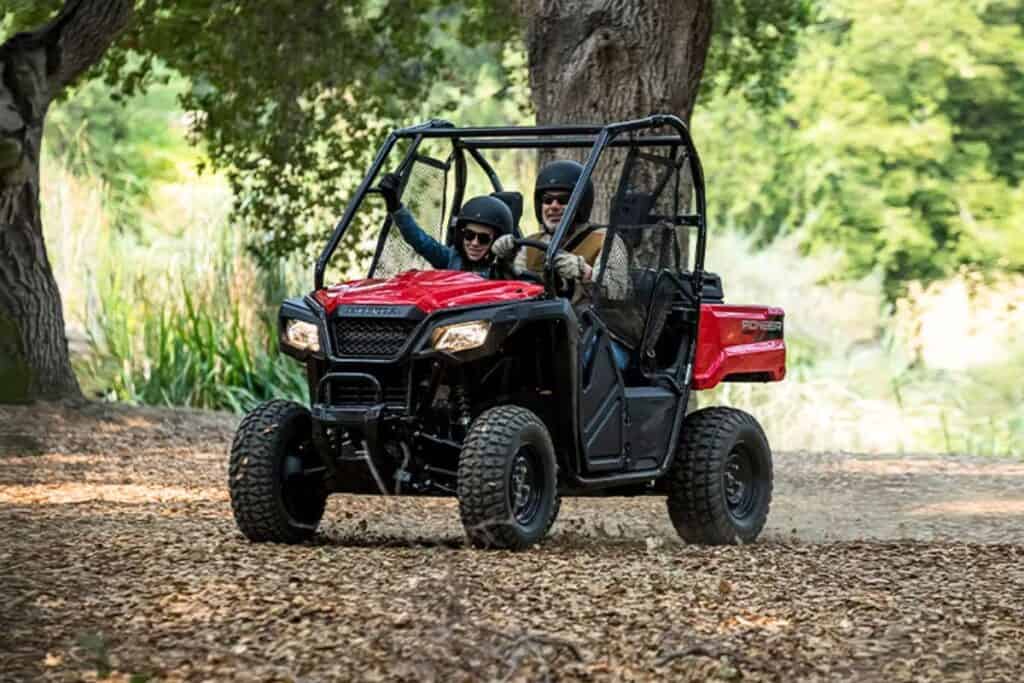
Lightweight side-by-sides which generally weigh between 1,000 and 1,300 pounds offer nimble handling, easy maneuverability, and efficient performance.
These models are perfect for those who want agility and convenience without compromising functionality.
Some of the most popular lightweight side-by-side models on the market today include:
- Kawasaki Mule SX – 967.6 lbs
- Honda Pioneer 500 – 1,027 lbs
- Honda Pioneer 520 – 1,058 lbs
- Massimo Motor Buck 450 – 1,113 lbs
- Polaris Ranger SP 570 – 1,158 lbs
- Can-Am Maverick Trail 700 – 1,256 lbs
Mid-Size Side By Sides: (1,300 – 1,600 Pounds)
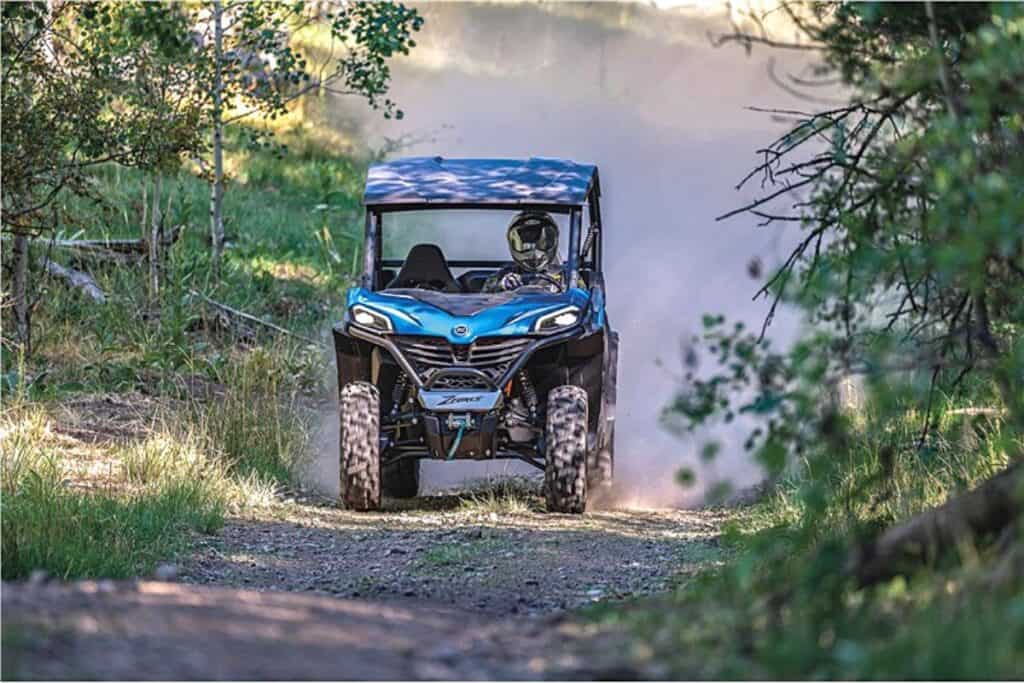
Mid-size side-by-sides usually fall between 1,300 and 1,600 pounds and offer a great balance of performance, utility, and comfort.
Making them suitable for a wide range of off-road adventures and work-related tasks.
Designed to offer the agility of lightweight models and the power and capability of heavy-duty options, these machines provide a comfortable and confident rider experience while still being able to tackle challenging terrain and haul moderate loads.
Some of the most popular midweight UTVs include:
- John Deere XUV560E – 1,259 lbs
- CFMoto UForce 600 – 1,356 lbs
- Can-Am Maverick Trail DPS 1000 – 1,364 lbs
- CFMoto ZForce 800 Trail EPS – 1,390 lbs
- Yamaha YXZ 1000R – 1,574 lbs
Heavy-Duty UTVs: (1,600 – 1,800 Pounds)
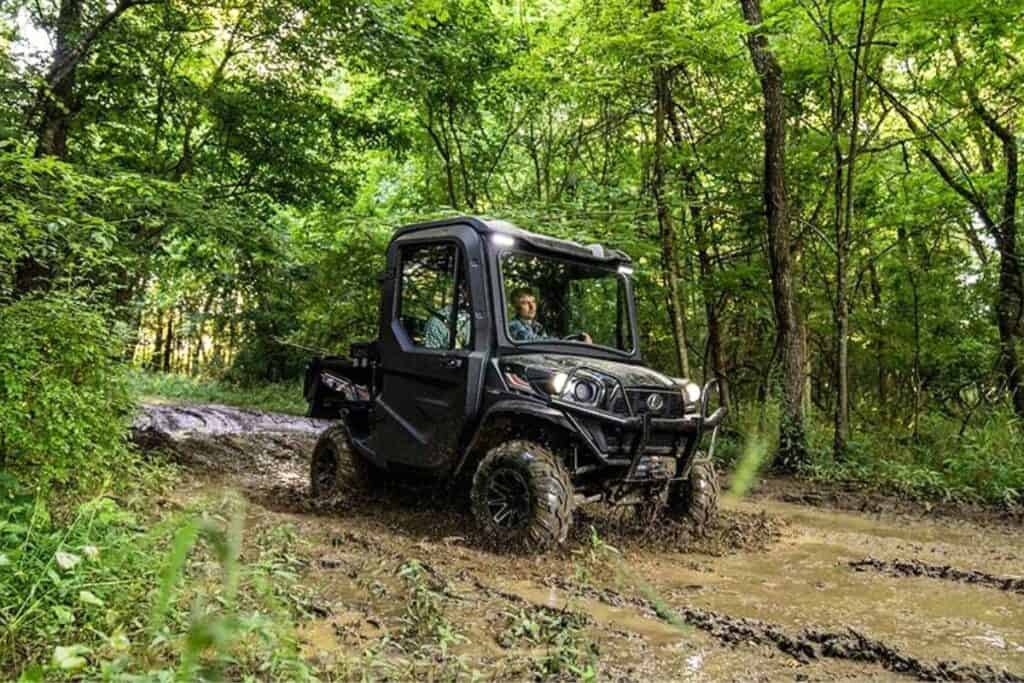
For those who require maximum power, capability, and durability, heavy-duty side-by-sides are the way to go.
These machines, which usually weigh between 1,600 and 1,800 pounds are designed to tackle the toughest terrain, haul the heaviest loads, and withstand demanding work environments year after year.
With their powerful engines, robust construction, and advanced features, they offer unparalleled capability and durability.
Some of the top heavy-duty side-by-side models on the market today include:
- Honda Pioneer 1000 – 1,598 lbs
- Arctic Cat Prowler Pro EPS – 1,605 lbs
- Segway Fugleman UT10 – 1,653 lbs
- Can-Am Commander XT 1000 – 1,675 lbs
- Kubota Sidekick RTV-XG850 – 1,761 lbs
- Yamaha Viking VI EPS – 1,761 lbs
- Can-Am Defender Cab DPS HD9 – 1,830 lbs
High-Performance Side-By-Sides: (1,800 – 2,000+ Pounds)
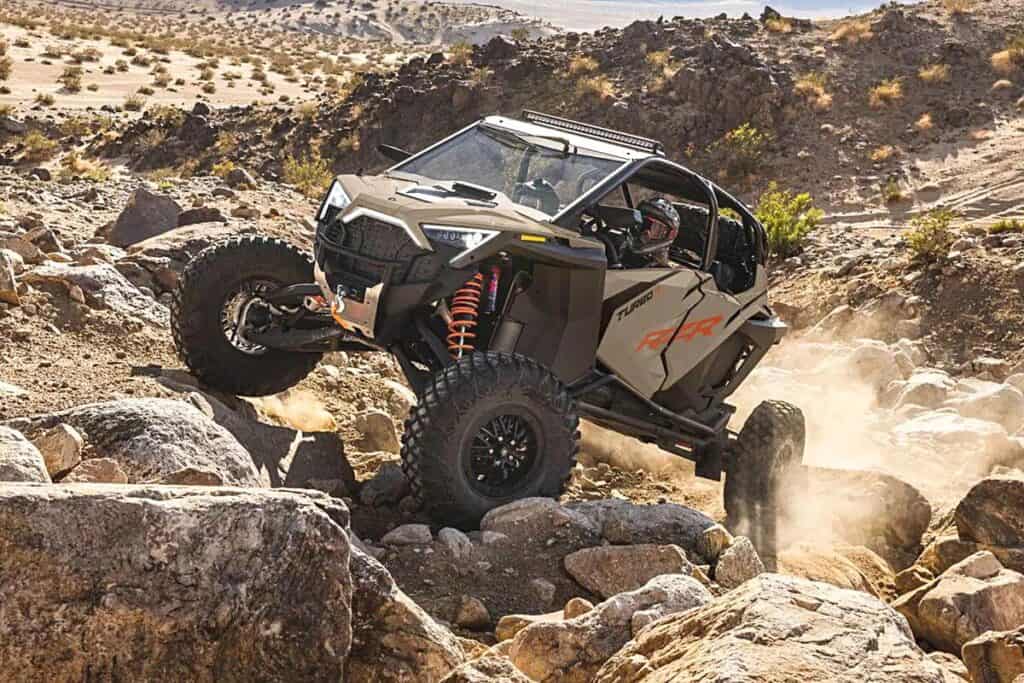
For adrenaline junkies and off-road enthusiasts who crave the ultimate in power, speed, and agility, high-performance side-by-sides are the pinnacle of the off-road world.
These vehicles, which usually weigh between 1,800 and 2,000 pounds are designed to push the limits of what’s possible, offering unparalleled acceleration, handling, and suspension capabilities.
Some of the most impressive high-performance side-by-side models available include:
- Honda Talon 1000X-4 Fox Live Valve – 1,790 lbs
- Kawasaki Teryx KRX 1000 – 1,896.3 lbs
- Arctic Cat Wildcat XX Black Hills Edition – 1,918 lbs
- Segway Villain SX10 WX – 1,940 lbs
- Polaris RZR Turbo R Ultimate – 2,013 lbs
Factors that Affect Side-by-Side Weight
When figuring out the weight of a side-by-side, it’s important to understand the various factors that contribute to its overall weight.
In this section, we’ll explore the various components that affect a side-by-side’s weight, including engine size and type, construction materials, vehicle size, and more.
Engine Size & Type
The engine is one of the most significant contributors to a side-by-side’s weight.
Larger, more powerful engines generally weigh more than smaller, less capable ones. For example, a 1,000cc engine will typically be substantially heavier than a 500cc engine.
In addition, the type of engine can affect weight as well, with liquid-cooled engines often being heavier than air-cooled ones due to the added components required for the cooling system.
Construction Materials
The materials used to construct a side-by-side frame, body panels, and other components can greatly impact its overall weight.
Steel is a common choice for its strength and durability, but it’s also heavier than alternative materials like aluminum or plastic.
Manufacturers often use a combination of materials to strike a balance between weight, strength, and cost. For example, a side-by-side may feature a steel frame for rigidity and aluminum or plastic body panels for weight reduction.
Size & Dimensions of the Machine
A side-by-side’s size and dimensions directly influence its weight.
Larger vehicles with longer wheelbases, wider stances, and taller profiles will generally weigh more than smaller, more compact models.
Additional Features & Accessories
The inclusion of additional features and accessories can significantly impact a side-by-side’s weight. For example, a fully enclosed cab with doors, windows, and a roof will add considerable weight compared to an open-air design.
Other features like winches, plows, and heavy-duty suspensions can also add considerable weight to the UTV.
Seating Capacity & Configuration
The number of passengers a side-by-side can accommodate can also impact its weight.
Models with seating for four or six passengers will generally be heavier than those designed for two.
Additionally, the type of seating, such as bench seats or individual bucket seats, can affect the vehicle’s weight distribution and overall mass.
Fuel Capacity
While often overlooked, the amount of fuel a side-by-side can carry can also affect its weight, as a gallon of fuel generally weighs just over 6 pounds.
So every gallon of extra fuel capacity the UTV offers will add approximately 6 pounds to its overall weight.
Why UTV Weight Matters
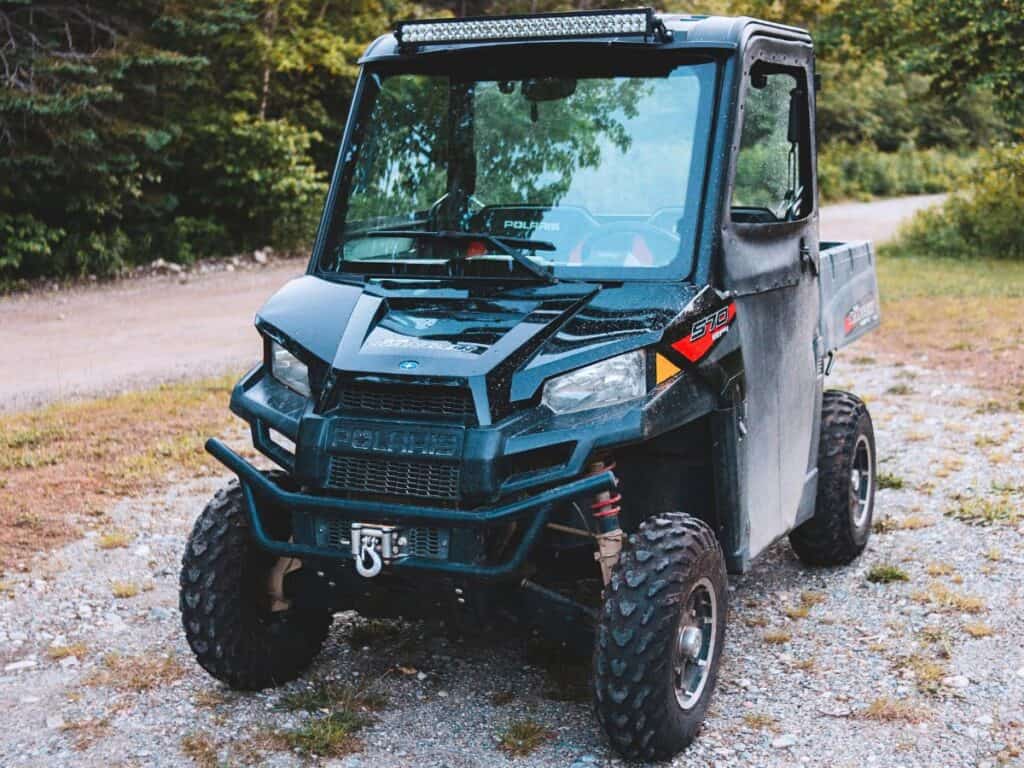
The weight of a side-by-side can impact many of its characteristics, affecting everything from its maneuverability and handling to its acceleration and towing capacity.
In this section, we’ll explore the impact of weight on all these factors and more, to provide a better understanding of how weight directly impacts UTV performance.
Maneuverability & Handling
UTV weight plays a large role in its overall handling, with lighter models being more agile and easier to maneuver, especially in tight spaces or narrow trails. These lighter models typically have a lower center of gravity, which can improve stability and reduce the risk of rollovers and flips.
However, lighter machines are also more susceptible to being pushed around by rough terrain and strong winds.
On the other hand, heavier side-by-sides can feel more planted and stable, particularly at higher speeds or in rough conditions.
The increased weight can help the vehicle maintain its composure and track straight through challenging obstacles.
Acceleration & Top Speed
The weight of a side-by-side can also impact its acceleration and top speed.
Lighter vehicles typically have a better power-to-weight ratio, which means they can accelerate more quickly and reach higher top speeds than heavier models with similar engine power.
This can be particularly advantageous for sport/trail models designed for high-performance off-road adventures.
However, it’s important to note that other factors, such as engine size, transmission gearing, and power delivery, also play significant roles in a side-by-side’s acceleration and top speed capabilities.
Towing Capacity & Payload
A side-by-side’s weight can also affect its towing capacity and payload.
Heavier vehicles typically have more robust suspensions, frames, and other components that allow them to handle larger loads and tow heavier trailers.
This can be particularly important for utility models used for work-related tasks or hauling heavy gear.
Fuel Efficiency
The weight of a UTV can also impact its fuel efficiency.
Heavier vehicles generally require more power to move, which can result in increased fuel consumption compared to lighter models with similar engine sizes.
This can be an important thing to keep in mind for those who prioritize fuel economy or plan to use their side-by-side for long distances.
Got More Side By Side Weight Questions? We’ve Got More Answers…
Additional Side By Side Resources:
- How Much Horsepower Does a UTV Have? (23 Models Compared)
- Average UTV Towing Capacity (19 Popular Models Compared)
- Are All UTVs 4×4? The Answer Might Suprise You
Recent Posts
Is Can-Am Better Than Polaris? This question has been debated for years, sparking intense debates in off-road communities and showrooms. As two titans in the world of ATVs and UTVs, Can-Am and...
Whether you're an adult looking for a new adventure or introducing your kids to the sport, finding the best beginner dirt bike is crucial to kick-start your off-road journey on the right...

